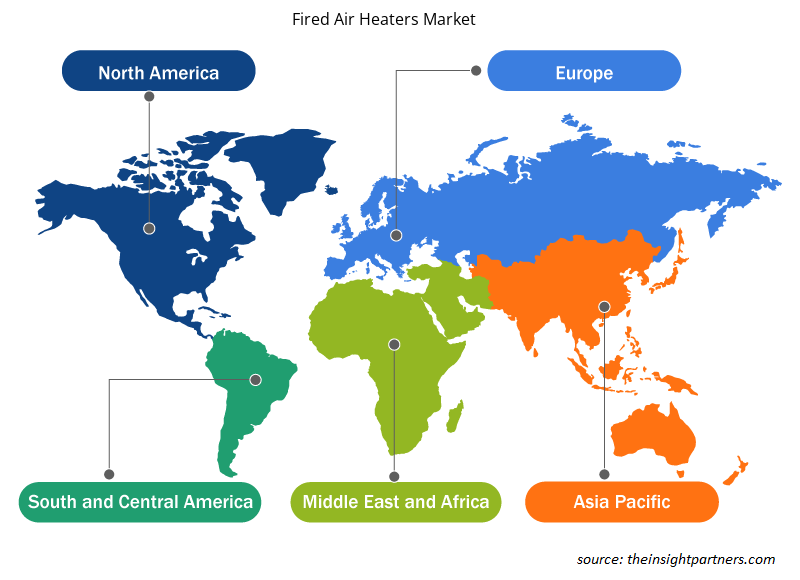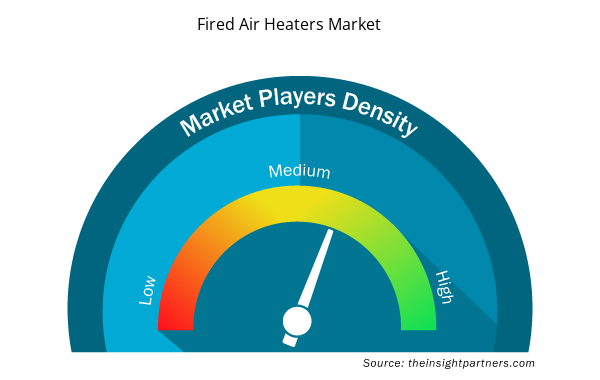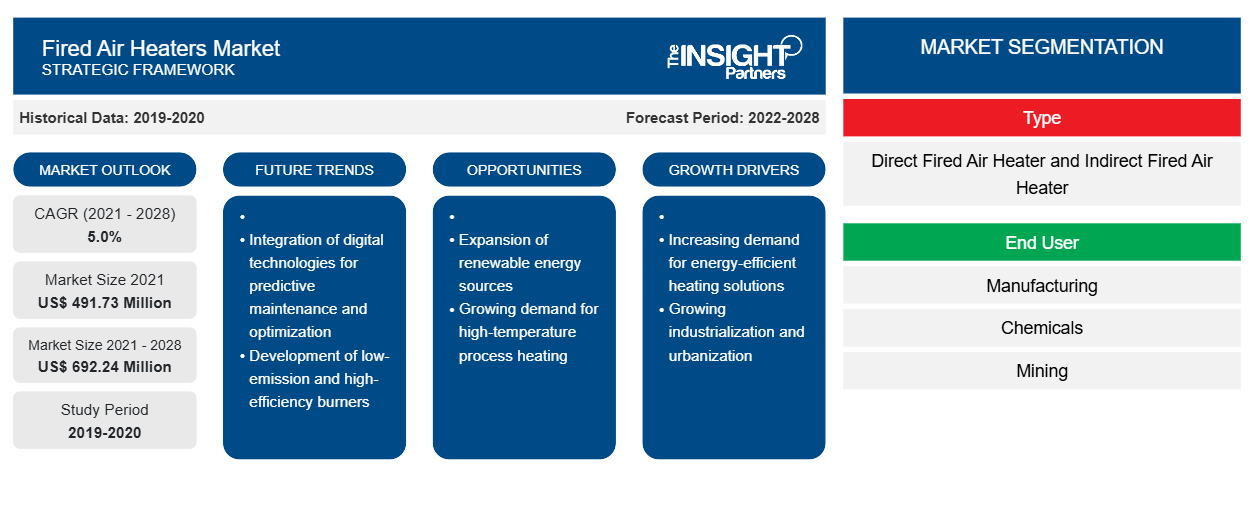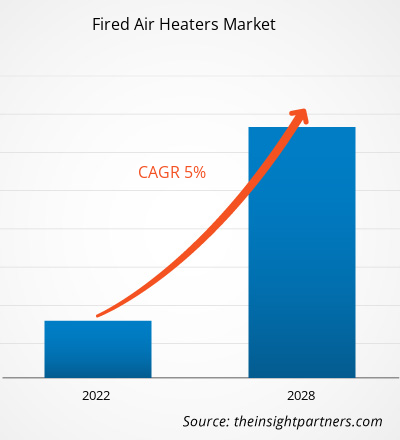预计燃气空气加热器市场规模将从 2021 年的 4.9173 亿美元增长至 2028 年的 6.9224 亿美元;预计 2021 年至 2028 年的复合年增长率为 5.0%。
新兴国家对工业用加热设备的需求上升是燃烧空气加热器市场的主要驱动力。中国、印度、日本和巴西等新兴经济体的企业对能源需求的增加推动了对燃烧空气加热器的需求。此外,由于启动时间短、效率高、可靠性高,制造、发电和加工领域对燃烧空气加热器的需求也随之增加。此外,发电能力投资的增加也是燃烧空气加热器的另一个驱动因素。由于产品生产技术数十年来的发展,对燃烧空气加热器的需求继续大幅扩大。
燃烧空气加热器通常用于加工行业,将气体或液体加热到特定温度。此外,物联网 (IoT) 在燃烧空气加热器中的集成将增加燃烧空气加热器的采用,从而在预测期内推动市场增长。
定制此报告以满足您的需求
您可以免费定制任何报告,包括本报告的部分内容、国家级分析、Excel 数据包,以及为初创企业和大学提供优惠和折扣
- 获取此报告的关键市场趋势。这个免费样品将包括数据分析,从市场趋势到估计和预测。
COVID-19 疫情对燃气空气加热器市场的影响
COVID-19 疫情对世界产生了重大影响,并继续摧毁多个国家。在 COVID-19 爆发之前,燃烧空气加热器行业的产量大幅增长。不幸的是,COVID-19 疫情导致全球不同行业对燃烧空气加热器的需求大幅下降,反映出飞机制造商的订单量大幅下降,导致产量下降。产量下降对各零部件制造商和相关技术的业务产生了不利影响。此外,建筑、汽车和采矿业等终端用户的疲软削弱了市场的积极性。因此,燃烧空气加热器市场参与者的业务受到生产不稳定的严重影响。在 COVID-19 病毒广泛传播期间,整个建筑行业陷入停顿,资源极少,无法预见未来。美国、法国、俄罗斯和中国的几家生产单位暂时停工,以遵守政府关于封锁和保持社交距离的规定。建筑企业的新项目需求减少了 20-30%。此外,在建工程暂停也进一步削弱了市场,对燃气空气加热器市场产生了负面影响。
火焰空气加热器市场洞察
工业用加热设备需求增加
锅炉、热泵和熔炉是化工、食品、建筑、采矿和其他行业用于进行生产过程的工业加热设备。锅炉是一种封闭的容器,水或其他液体在其中被加热并形成蒸汽,随后在高压下分配时用于驱动机器。此外,热泵是一种将热量传递到温暖或凉爽区域的设备。此外,熔炉是中央供暖系统的重要组成部分。在胺和乙二醇再沸器中,必须从烃蒸汽中去除腐蚀性的硫化氢和二氧化碳气体,然后才能将相应的燃料储存或引入天然气和原油精炼管道。与天然气蒸汽类似,乙二醇用于在分配之前从天然气中去除水分。由于维护成本低且简单,这种类型的加热器用于天然气、原油和加工行业。在化学过程领域,火焰加热器通常用于加热工艺流体并产生蒸汽。
在大多数情况下,火焰加热器是过程工业中消耗能量最多的加热器。本研究使用带有垂直管的箱式加热器来加热碳氢化合物流体。洗脱加热器是火焰空气加热器的一种特殊应用,需要独特的设计,用于采矿业。洗脱是在分析和有机化学中,用溶剂洗涤从另一种材料中提取一种材料的过程,几乎总是伴随着加热。使用交换器可以提取黄金等矿物。矿物和溶剂溶液在交换器的一侧循环,传热流体(通常是热流体)在另一侧分布。在食品工业中,特别是在油炸列车中(土豆、小吃和预煮食品),是通过传热流体加热器,其中热流体在设备中循环,加热后,其热量通过交换传递到油炸上述产品的油中。这里已经进行了一些安装,类似于采矿洗脱过程,其中煎炸油直接通过锅炉循环,随后用作燃烧空气加热器。直接燃烧加热器偶尔用作石化工业中的传热流体加热器或间接加热器。化工厂和炼油厂的直接燃烧加热器维护服务的良好运行和备件的统一性是这种采用的主要原因,因为传热流体加热器以其特定功能的优势而闻名。因此,各种工业应用对加热设备的需求增加正在推动燃烧空气加热器市场的发展。
基于类型的市场洞察
根据类型,燃烧式空气加热器市场分为直接燃烧式空气加热器和间接燃烧式空气加热器。直接燃烧式加热器通过保持适当的空气与燃料的比率(天然气或丙烷)为工业环境提供安全加热方式。气体直接输送到直接燃烧式加热器中的燃烧器,而气流则提供燃烧所需的氧气。气体与通过燃烧器挡板的空气混合。燃烧器设置为与气流同时并联燃烧。由于大约 100% 的燃料转化为热量,因此燃料消耗和运行费用降低。
燃油空气加热器市场区域洞察
Insight Partners 的分析师已详尽解释了预测期内影响燃气空气加热器市场的区域趋势和因素。本节还讨论了北美、欧洲、亚太地区、中东和非洲以及南美和中美洲的燃气空气加热器市场细分和地理位置。

- 获取燃气空气加热器市场的区域特定数据
火焰空气加热器市场报告范围
| 报告属性 | 细节 |
|---|---|
| 2021 年市场规模 | 4.9173亿美元 |
| 2028 年市场规模 | 6.9224亿美元 |
| 全球复合年增长率(2021 - 2028) | 5.0% |
| 史料 | 2019-2020 |
| 预测期 | 2022-2028 |
| 涵盖的领域 | 按类型
|
| 覆盖地区和国家 | 北美
|
| 市场领导者和主要公司简介 |
|
燃烧空气加热器市场参与者密度:了解其对业务动态的影响
燃烧空气加热器市场正在快速增长,这得益于终端用户需求的不断增长,这些需求源于消费者偏好的不断变化、技术进步以及对产品优势的认识不断提高等因素。随着需求的增加,企业正在扩大其产品范围,进行创新以满足消费者的需求,并利用新兴趋势,从而进一步推动市场增长。
市场参与者密度是指在特定市场或行业内运营的企业或公司的分布情况。它表明相对于给定市场空间的规模或总市场价值,有多少竞争对手(市场参与者)存在于该市场空间中。
在燃气空气加热器市场运营的主要公司有:
- ALLMAND 兄弟公司
- 艾瑟姆公司
- 黑斯廷斯暖通空调公司
- 南非皮罗布洛克
- 西格玛热能有限公司
免责声明:上面列出的公司没有按照任何特定顺序排列。

- 获取燃气空气加热器市场顶级关键参与者概览
燃烧空气加热器市场的参与者采用合并、收购和市场计划等策略来维持其市场地位。以下列出了一些主要参与者的发展:
- 2018 年,Allmand Bros. Inc.(一家拥有 80 年历史的高性能便携式施工现场设备制造商,也是 Briggs & Stratton Corporation 的子公司)扩建了其位于内布拉斯加州霍尔德里奇的现有工厂,以通过新技术提高制造能力和产品上市速度。
- 2018 年,导热油加热器设计和制造领域的领导者 Pirobloc 在美国开设了一家子公司。Pirobloc USA 现已成立,并全面投入运营。
全球火焰空气加热器市场细分如下:
燃气空气加热器市场 – 按类型
燃气空气加热器市场 – 按最终用户划分
- 制造业
- 化学品
- 矿业
- 仓库
- 石油和天然气
- 药品
- 其他的
燃气空气加热器市场 – 按地区划分
- 北美
- 我们
- 加拿大
- 墨西哥
- 欧洲
- 德国
- 法国
- 意大利
- 英国
- 俄罗斯
- 欧洲其他地区
- 亚太地区 (APAC)
- 澳大利亚
- 中国
- 印度
- 日本
- 韩国
- 亚太地区其他地区
- 中东和非洲 (MEA)
- 南非
- 沙特阿拉伯
- 阿联酋
- MEA 其他地区
- 南美洲 (SAM)
- 巴西
- 阿根廷
- SAM 其余部分
公司简介
- ALLMAND 兄弟公司
- 艾瑟姆公司
- 黑斯廷斯暖通空调公司
- 南非皮罗布洛克
- 西格玛热能有限公司
- 斯特尔特与布林克有限公司
- 塔马拉克工业公司
- 热力学
- 威克诺森
- Zeeco 公司
- 历史分析(2 年)、基准年、预测(7 年)及复合年增长率
- PEST 和 SWOT 分析
- 市场规模价值/数量 - 全球、区域、国家
- 行业和竞争格局
- Excel 数据集



Report Coverage
Revenue forecast, Company Analysis, Industry landscape, Growth factors, and Trends

Segment Covered
This text is related
to segments covered.

Regional Scope
North America, Europe, Asia Pacific, Middle East & Africa, South & Central America

Country Scope
This text is related
to country scope.
常见问题
The key players operating in the global fired air heaters market include Allmand Bros., Inc. (Briggs & Stratton); Exotherm Corporation; Pirobloc, S.A.; Hastings HVAC; Wacker Neuson SE; Zeeco, Inc.; Stelter & Brinck, Ltd.; and Therm Dynamics. Major players in the market have adopted product launch and business expansion as their key developmental strategies to offer better products and services to customers in the fired air heaters industry.
In 2020, North America dominated the fired air heater market. The region's large market share can be attributed to the presence of many manufacturers in the region. The region comprises prominent market players such as Allmand Bros., Inc. (Briggs & Stratton); Cambridge Air Solutions; Exotherm Corporation; Hastings HVAC; JetHeat, LLC; Stelter & Brinck, Ltd.; and Therm Dynamics, with a considerable customer base, big contracts, and strong market positioning. These market players have significantly invested in expanding their business competencies to sustain their market position.
The construction industry is one of the industries which continue to grow year on year, with the rising demand for industrial complexes. The use of fired air heaters is becoming more popular in the construction industry. Outside the buildings, there are usually natural gas, propane, or diesel-fired heaters. The fuel is burned in an enclosed combustion chamber with combustion air drawn in from outside the structure. The flame heats a heat exchanger, which indirectly warms outside air that is fan-driven into the building via air ducts. Warm air can be distributed throughout the work area using these ducts, installed as needed. Electricity is required to run these units, and they are less efficient than direct-fired units. However, the additional safety they give often outweighs these disadvantages. Because the burner and fuel supply are outside the building, the risk of a fire is reduced. They also provide fresh air to the work area, lowering carbon monoxide and oxygen depletion concerns.
Based on the type, the fired air heaters market is segmented into direct fired air heaters, and indirect fired air heaters. The global fired air heaters market is dominated by direct fired air heaters segment in 2020, which accounted for 69.6%.
Major players in the market have adopted product launch and business expansion as their key developmental strategies to offer better products and services to customers in the fired air heaters industry. The various strategic initiatives of market players are:
Sigma Thermal combined with Flarectec in April 2019 to increase its capacity to supply high-quality heating solutions for industrial applications. It has strengthened its direct fired heater experience and product line by working together. Radiant-convective heaters, convection heaters, and radiant heaters are among the three types of direct-fired heaters that it designs and manufactures. API 560 is a design code for direct-fired heaters that is widely used. Flaretec direct-fired heaters can be developed and built to meet all or part of the API 560 requirements.
Rise in Demand for Heating Equipment for Industrial Application
Boilers, heat pumps, and furnaces are industrial heating equipment used in chemical, food, construction, mining, and other industries to carry out production processes. A boiler is a closed vessel in which water or another liquid is heated and steam is formed, subsequently used to drive machines when dispensed under high pressure. Furthermore, a heat pump is a device that transfers heat to warm or cool areas. Moreover, furnaces are essential components of a central heating system. In amine and glycol reboilers, the corrosive hydrogen sulfide and carbon dioxide gases must be removed from hydrocarbon steam before the respective fuels may be stored or introduced into the pipeline in natural gas and crude oil refining. Similar to natural gas steam, glycol is used to remove water from natural gas before distribution. Because of its cheap maintenance and simplicity, this type of heater is used in natural gas, crude oil, and processing sectors
Trends and growth analysis reports related to Manufacturing and Construction : READ MORE..
The List of Companies - Fired Air Heaters Market
- ALLMAND BROS., INC
- Exotherm Corporation
- Hastings HVAC, Inc.
- Pirobloc, S.A.
- SIGMA THERMAL, INC
- Stelter & Brinck, Ltd.
- Tamarack Industries
- Therm Dynamics
- Wacker Neuson SE
- Zeeco, In
The Insight Partners performs research in 4 major stages: Data Collection & Secondary Research, Primary Research, Data Analysis and Data Triangulation & Final Review.
- Data Collection and Secondary Research:
As a market research and consulting firm operating from a decade, we have published and advised several client across the globe. First step for any study will start with an assessment of currently available data and insights from existing reports. Further, historical and current market information is collected from Investor Presentations, Annual Reports, SEC Filings, etc., and other information related to company’s performance and market positioning are gathered from Paid Databases (Factiva, Hoovers, and Reuters) and various other publications available in public domain.
Several associations trade associates, technical forums, institutes, societies and organization are accessed to gain technical as well as market related insights through their publications such as research papers, blogs and press releases related to the studies are referred to get cues about the market. Further, white papers, journals, magazines, and other news articles published in last 3 years are scrutinized and analyzed to understand the current market trends.
- Primary Research:
The primarily interview analysis comprise of data obtained from industry participants interview and answers to survey questions gathered by in-house primary team.
For primary research, interviews are conducted with industry experts/CEOs/Marketing Managers/VPs/Subject Matter Experts from both demand and supply side to get a 360-degree view of the market. The primary team conducts several interviews based on the complexity of the markets to understand the various market trends and dynamics which makes research more credible and precise.
A typical research interview fulfils the following functions:
- Provides first-hand information on the market size, market trends, growth trends, competitive landscape, and outlook
- Validates and strengthens in-house secondary research findings
- Develops the analysis team’s expertise and market understanding
Primary research involves email interactions and telephone interviews for each market, category, segment, and sub-segment across geographies. The participants who typically take part in such a process include, but are not limited to:
- Industry participants: VPs, business development managers, market intelligence managers and national sales managers
- Outside experts: Valuation experts, research analysts and key opinion leaders specializing in the electronics and semiconductor industry.
Below is the breakup of our primary respondents by company, designation, and region:

Once we receive the confirmation from primary research sources or primary respondents, we finalize the base year market estimation and forecast the data as per the macroeconomic and microeconomic factors assessed during data collection.
- Data Analysis:
Once data is validated through both secondary as well as primary respondents, we finalize the market estimations by hypothesis formulation and factor analysis at regional and country level.
- Macro-Economic Factor Analysis:
We analyse macroeconomic indicators such the gross domestic product (GDP), increase in the demand for goods and services across industries, technological advancement, regional economic growth, governmental policies, the influence of COVID-19, PEST analysis, and other aspects. This analysis aids in setting benchmarks for various nations/regions and approximating market splits. Additionally, the general trend of the aforementioned components aid in determining the market's development possibilities.
- Country Level Data:
Various factors that are especially aligned to the country are taken into account to determine the market size for a certain area and country, including the presence of vendors, such as headquarters and offices, the country's GDP, demand patterns, and industry growth. To comprehend the market dynamics for the nation, a number of growth variables, inhibitors, application areas, and current market trends are researched. The aforementioned elements aid in determining the country's overall market's growth potential.
- Company Profile:
The “Table of Contents” is formulated by listing and analyzing more than 25 - 30 companies operating in the market ecosystem across geographies. However, we profile only 10 companies as a standard practice in our syndicate reports. These 10 companies comprise leading, emerging, and regional players. Nonetheless, our analysis is not restricted to the 10 listed companies, we also analyze other companies present in the market to develop a holistic view and understand the prevailing trends. The “Company Profiles” section in the report covers key facts, business description, products & services, financial information, SWOT analysis, and key developments. The financial information presented is extracted from the annual reports and official documents of the publicly listed companies. Upon collecting the information for the sections of respective companies, we verify them via various primary sources and then compile the data in respective company profiles. The company level information helps us in deriving the base number as well as in forecasting the market size.
- Developing Base Number:
Aggregation of sales statistics (2020-2022) and macro-economic factor, and other secondary and primary research insights are utilized to arrive at base number and related market shares for 2022. The data gaps are identified in this step and relevant market data is analyzed, collected from paid primary interviews or databases. On finalizing the base year market size, forecasts are developed on the basis of macro-economic, industry and market growth factors and company level analysis.
- Data Triangulation and Final Review:
The market findings and base year market size calculations are validated from supply as well as demand side. Demand side validations are based on macro-economic factor analysis and benchmarks for respective regions and countries. In case of supply side validations, revenues of major companies are estimated (in case not available) based on industry benchmark, approximate number of employees, product portfolio, and primary interviews revenues are gathered. Further revenue from target product/service segment is assessed to avoid overshooting of market statistics. In case of heavy deviations between supply and demand side values, all thes steps are repeated to achieve synchronization.
We follow an iterative model, wherein we share our research findings with Subject Matter Experts (SME’s) and Key Opinion Leaders (KOLs) until consensus view of the market is not formulated – this model negates any drastic deviation in the opinions of experts. Only validated and universally acceptable research findings are quoted in our reports.
We have important check points that we use to validate our research findings – which we call – data triangulation, where we validate the information, we generate from secondary sources with primary interviews and then we re-validate with our internal data bases and Subject matter experts. This comprehensive model enables us to deliver high quality, reliable data in shortest possible time.


 获取此报告的免费样本
获取此报告的免费样本